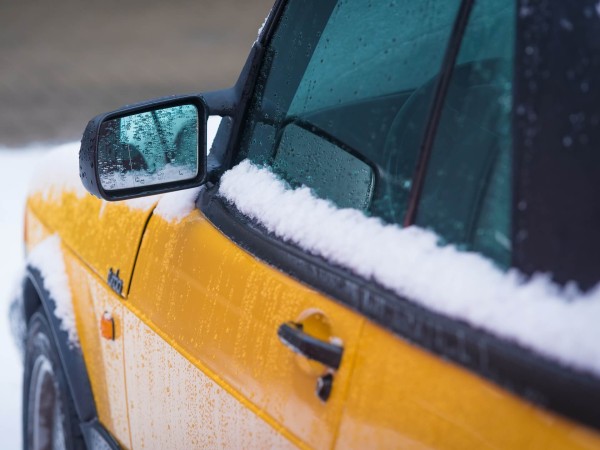Many owners who love their convertibles and take good care of them, will leave them dormant over winter. In Germany, you can save money on your road tax by registering your car only for specific months. And it can help protect the car, too. Cold, snow and road salt all cause wear to cars so it makes sense not to use your convertible over winter. However, depending on your lifestyle, we know it may not be possible to go without your car. For example, if your convertible is your only car, you will of course need to drive it in winter. There are still some precautions every owner should take to minimise any winter damage to their convertible. Here are our tips for caring for your convertible through the winter.
Contents
- Driving a convertible in winter: What you should know
- Park up for the winter: No miles, no problem
- Summary: Proper preparation is key
Driving a convertible in winter: What you should know
In essence, there is no reason not to drive your convertible throughout the winter. In modern cars, the folding roof seals thoroughly and is well insulated so you will stay both warm and dry. And even older models can be safe and comfortable choices for winter with a few precautions. Use the following principles to give your car the best possible protection from cold, snow and corrosive road salt.
Don’t use the convertible roof!
This part is the bad news: No wind in your hair over winter. Especially if the temperature is close to freezing. The cold can make the rubber seals and soft top brittle, so the movement of raising or lowering the roof can end up causing damage. Plus, if the roof is frozen in place, trying to drop the convertible top can damage its motor.
We recommend using a specialist care product to protect the hood and mechanism in winter. This helps the rubber (don’t forget the door seals) to stay supple. Silicone-based care products are ideal for preventing winter damage to plastic parts and a coating spray can be used to treat the soft top, waterproofing the fabric and helping dirt to slide off. However, the frequent rain and even snow in winter will quickly remove the protective layer so it is important to reapply the spray regularly.
Be especially careful when using de-icer on the windscreen as it contains chemicals that could damage your soft top. Ideally, use an ice scraper instead. But remember: On some convertibles, the rear windscreen in the hood is made of plastic, not glass. This plastic is easily scratched when using an ice scraper.
Regular cleaning is good protection
The biggest problem for convertibles in winter is the salt on the road that clings to the car and attacks the bodywork. This can cause increased rusting. Better to leave the car at home in ice and snow. If you need to use your car, you should ensure that you clean it regularly. Rinse the underbody thoroughly to remove any salt that has stuck and reduce the risk of long-term damage.
It can be tricky to properly clean underneath the car yourself, so we recommend taking it to a car wash but do make sure that it uses soft, fabric cloths rather than hard brush rollers. Sealing the paint with wax or a specialist protective coating can help but it can also damage the soft top so a basic wash is sufficient.
Check liquids and frost protection
Your convertible’s engine also needs preparing for cold winter weather. Make sure you top up all consumable liquids: coolant, screen wash, oil, etc. And don’t forget frost protection as frost damage can be expensive. Protection is recommended for temperatures down to -30°C to ensure that the mechanisms can handle the cold.
Of course, the usual winter driving precautions apply: Always use winter tyres when driving in snow and ice. These carry the ‘Alpine’ symbol (a snowflake on a stylised mountain) on the side. In Germany, the legal minimum tyre tread is 1.6 mm but a remaining tread depth of 4 mm is better. Make sure your lights are working properly, too.
If you can, find a covered spot to park in
Where you park matters. In the ideal case scenario, convertibles are stored in dry garages. But not every car owner has this luxury. A carport is still better than outdoors. And if you can’t find a covered parking space, a mobile garage can help you create one. These specially designed shelters protect your paintwork and soft top from the elements.
Park up for the winter: No miles, no problem

If you own a second car that you can use in winter, simply don’t use your convertible out of season. In Germany, you can choose to register your car only for specific months, saving money on road tax and insurance. This strategy also protects your car from the impact of snow, ice and road salt. Take some key precautions before the winter, though, so there are no nasty surprises when you return to your convertible in spring.
Increase the air pressure in your tyres
Tyres do not take kindly to being left to stand for several months without moving. This can cause damage and even flat tyres. When setting up for the winter, it is therefore recommended to increase the tyre pressure to 3–4 bar. You should also roll your car forwards and backwards occasionally over the winter so that the weight sits on different parts of the tyres. You can use chalk markings to keep track of where the tyres have been in contact with the ground. An even better option is to raise your convertible off the ground for winter storage so that the tyres never actually touch the ground and the wheel bearings get a rest, too.
Disconnect the battery and charge it
The battery also suffers when a car is parked up for several months. For older vehicles, we recommend disconnecting or removing the battery before winter to avoid straining it. In modern cars with complex electronics, disconnecting the battery for a long period can actually cause problems. Regular charging (every two months) is recommended using a standard charger. Specialist chargers may feature a trickle charging function so that you can sit back and relax. Store the battery in a cool place where the temperature will not drop below zero. If the battery freezes, it can break.
Should you fill the tank full or drive until it’s empty?
Many drivers wonder whether it is better to fill up the tank or empty it in preparation for a winter of no driving. Opinion is split but a full tank offers the most advantages. It helps to prevent tank corrosion in older cars with metal tanks. Modern cars have plastic tanks, so rust will never form anyway. Yet it is still worth filling the tank before winter. It removes oxygen from the tank, limiting bacteria growth and leaving no surface area for condensation to form. Water from condensation can cause issues with starting the engine again in spring.
Check all liquids
Checking all liquids is vital. We advise changing your oil before your car stands over winter as old oil can lead to engine corrosion. If you are looking to put your convertible into storage for several years, you can fill the tank with specialist protective oil. This is not needed for a few months of winter downtime. Plus, you should ensure that your coolant contains a corrosion inhibitor and frost protection. You can also use frost protection for your screen wash, or you can drain it off. After all, even if your convertible is spending winter in the garage, the temperature can still drop below freezing and cause frost damage.
Avoiding damage: Inspect your paintwork
Thoroughly clean your car before winter. Really get into all the nooks and crannies. Various types of dirt (bird muck, tree resin, insects, etc.) can cause damage to the paintwork over winter so be really pernickety with your inspections. Any deep scratches or stone chips should be repaired before winter so that no rust can form. Dry your car thoroughly after cleaning, ensuring no water remains which could cause mould if your convertible is parked in a garage with low air flow.
Keep the interior clean and tidy
The interior matters, too! The pre-winter clean and tidy is the ideal time for a clear out. What do you actually use? Remove the mats from the footwells and store them elsewhere over winter as they can attract damp. Clean and treat the interior, especially the leather, to protect the material and keep it supple. And don’t forget the hood! Use specialist lubricant on the moving parts, joints and hinges. Rubber seals should also be treated to ensure they keep their seal. Use a protective coating on the roof fabric.
Important: Keep the convertible roof up over winter, or at most cracked open. Never all the way down.
The ideal parking space: No need for the handbrake
Can you leave a convertible outdoors over winter? This is a serious question for many owners. Of course, it is better to store your car in a dry garage or at least in a covered parking space. Really, a temperature-controlled room at approx. 15°C and 40% humidity would be ideal. But, in the absence of ideal, “mobile garages” are a good alternative. These are usually inflatable plastic shelters. The important thing is not to simply cover your car with a plastic sheet. Moisture can gather inside and cause mould. We recommend a breathable, yet soft and water-resistant, cover. Avoid putting the handbrake on as the brake pads can stick fast over winter and be very difficult to disengage in spring.
Summary: Proper preparation is key
Regardless whether you plan to continue driving your convertible through the winter or pack it away, proper preparation is the key to car care, keeping your convertible in great shape to enjoy for as long as possible. Here are some easy tips.
We recommend: Regularly checking on your car over winter so you can spot any issues early and avoid nasty surprises in spring. If you have a modern car, you can even run the engine for a few minutes to distribute the oil. This oils the seals and prevents damage, in particular to the air conditioning. Enjoy owning your convertible even over the winter months!
Images: hans engbers


